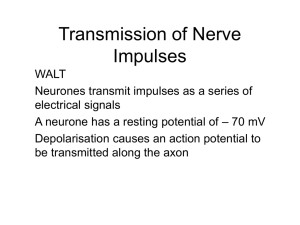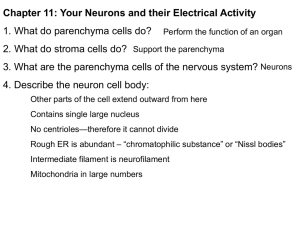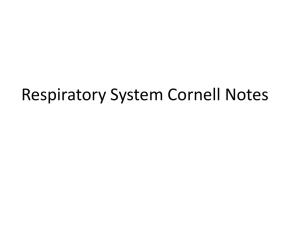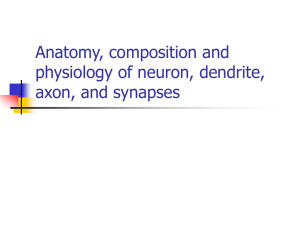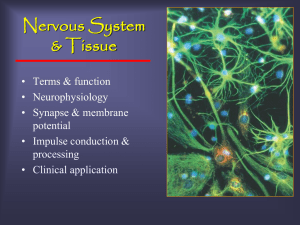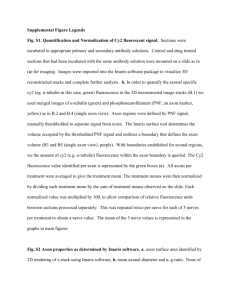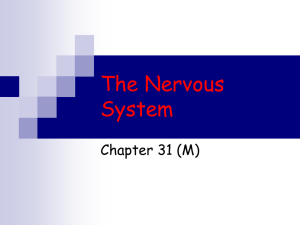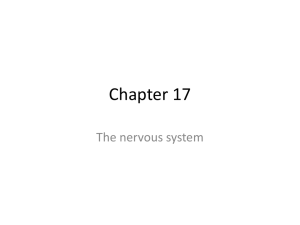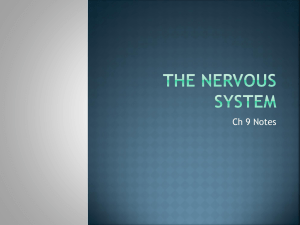Ppt
advertisement
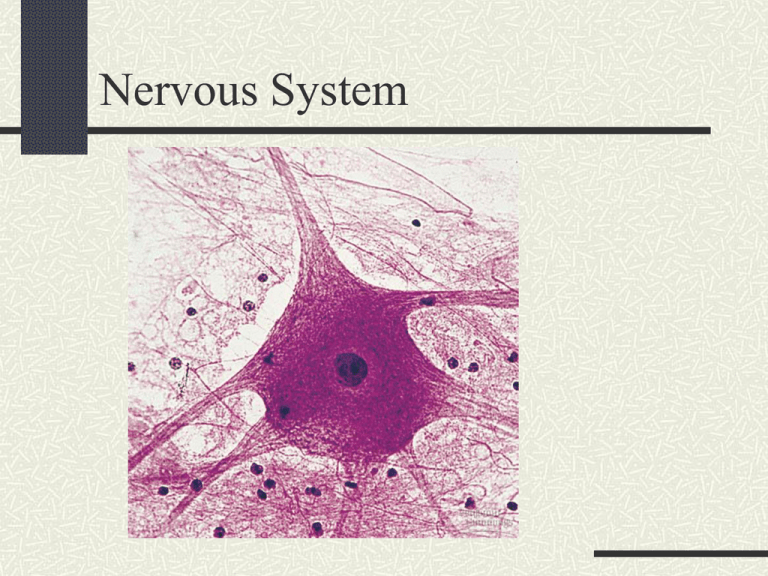
Nervous System Nervous System Functions Neurons Receptors: Interpret: Response: Afferent Efferent Organization of Nervous System Central Nervous System Peripheral Nervous System Motor (Efferent) Sensory(Afferent) ANS Somatic Sympathetic Parasympathetic “Fight or Flight” “Resting and Digesting” Cellular Organization: 2 types of Cells Neurons Responsible for conducting electrical impulses Characterisitics Long Life Span Amitotic High Metabolic Rate Dendrite, Cell Body and Axon Dendrites: Receive stimuli from receptors Cell Body: Contains nucleus and organelles; lacks centrioles Axon: Generate and transmit nerve impulses Secreting output Input conducting Sensory Neurons (Afferent) Exteroceptors Provide information of about external environment I.e. Proprioceptors Monitor the position of skeletal muscles and joints Interoceptors Monitor the activities of internal systems and organs I.e. Motor Neurons (Efferent) Carry Instructions from CNS to muscles, tissues and organs Called Effectors because they cause a response Interneurons Located in brain and spinal cord Analyze sensory input (afferent) and coordinate motor output (efferent) Neuroglia/Glial Cells Supporting cells to neurons Act as phagocytes Outnumber Neurons Mitotic Astrocytes Secretes chemicals important for the maintenance of the Blood Brain Barrier o Feeds neurons o Repairs damaged neural tissues Ependymal Cells Produce CSF (cerebrospinal fluid) Line central cavities of brain and spinal cord These ciliated cells circulate CSF Microglia Phagocytic cells Produced by leukocytes (WBCs) Fight infection Schwann Cells/Oligodendrocytes Produce myelin sheath -increases the speed of impulses, insulator Myelin=lipid components Nodes of Ranvier-gaps in myelin sheath, axon contacts its external environment Schwann cells-glial cells in PNS that produce myelin sheath Mylenated vs. Unmyelinated axons Demylinated (multiple sclerosis) Unmyleninated vs. Myleninated Axon Ion transport occurs along the length of the axon in an unmyleninated axon. Ion transport occurs only where the Nodes of Ranvier are located in a myleninated axon. Na+-K+ Pump Active Transport – requires ATP Resting Membrane Potential Measured as voltage difference across the membrane Inside of membrane is -70 mV (.07 V) C battery = 1.5 V Maintained by Na+K+ pump 3 Na ions are pumped out for every 2 K ions that are pumped in Requires ATP; maintaining a concentration gradient More Na+ leave the cell than K+ enter. Charge difference of -70mv across membrane Inside of axon is negative compared to the outside. Na ions and K ions are actively pumped out and in the cell. Maintain a concentration gradient (difference) Ions do not reach equilibrium. Depolarization Axon hillock is where impulse will begin Na diffuses into axon Reach -55mV = threshold At threshold Na gates open; Na ions diffuse into axon Reach +30 mV; Na gates close Graded Potential – depolarization occurs but you never reach threshold. Not enough Na+ moves into cell, impulse is not sent. Action Potential/Impulse Enough neurons fire so red neuron reaches threshold Impulse is sent to next neuron (green) Enough Na+ diffuses into the cell reaching threshold Na+ continues to diffuse into cell until voltage rises to +30 mV. Repolarization – Na gates close, K gates open. K+ diffuse out of cell Repolarization K+ ions diffuse out of the cell Returning the inside of the cell to its negative charge. Charge inside the axon goes below -70mV. Caused by K+ leaving the cell and Na+ not able to enter the cell. Increase in negative charge since + ions are leaving axon with no + ions being able to enter the neuron. Change in Ion permeability with Impulse. Why would Na+ enter the cell before K+? What is happening when Na+ enter the cell? What is happening when K+ leave the cell? Absolute Refractory Period •time needed to return the neuron’s membrane to Resting Membrane Potential •Limits the number of impulses that can be sent Intensity of Impulse Number of times impulse is sent More impulses; higher intensity Speed of Impulse Presence of Myelin Sheath Size of Neuron Large neurons = less resistance; impulse travels faster through neurons larger in diameter Axon Bud -Responsible for sending chemical messengers (neurotransmitter) across the synapse. -Synaptic vesicles release NT by exocytosis -Receptor cells on the dendrites receive the NT. Axon Bud Exocytosis requires ATP Axon Bud Animation Impulse travels to axon bud Ca ions enter through gated channels of axon bud. Ca attaches to vesicles; NT released by exocytosis. NT attaches to receptor cells on dendrite Na gates open in dendrite and Na ions begin to enter the dendrite. Reach Threshold = Action Potential How is the impulse stopped? As long as the NT remains attached to a receptor, it will continue to send impulses. NT is stopped by: Reuptake of NT into vesicles; begin as soon as impulse begins in postsynaptic neuron NT diffuses away from postsynaptic synapse Enzymes break down NT. I.e. neurotransmitter acetylcholine is broken down by acetylcholinerase Acetylcholine → acetate + choline What happens at the Axon Bud! Antidepressants
